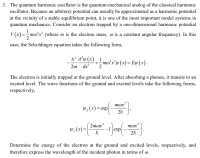The quantum harmonic oscillator is the quantum-mechanical analog of the classical harmonic oscillator. Because an arbitrary potential can usually be approximated as a harmonic potential at the vicinity of a stable equilibrium point, it is one of the most important model systems in
The electron is initially trapped at the ground level. After absorbing a photon, it transits to an excited level. The wave functions of the ground and excited levels take the following forms,respectively,
Determine the energy of the electron at the ground and excited levels, respectively, and therefore express the wavelength of the incident photon in terms of w.

Trending nowThis is a popular solution!
Step by stepSolved in 2 steps with 2 images

- The quantum mechanical tunneling process occurs if an electron is incident on a potential barrier of finite width a and finite height Uo. Calculate the transmission probability for this case assuming a barrier width a=1.4 nm and a barrier height Uo=2.6eV assuming that the energy of the electron is E=2.2eV. Give your result in % and round it off to two decimal places, i.e. the nearest hundredths. U(x) Uo 0 < E < Uo E 01 aarrow_forwardConsider a particle moving in a one-dimensional box with walls at x = -L/2 and L/2. (a) Write the wavefunction and probability density for the state n=1. (b) If the particle has a potential barrier at x =0 to x = L/4 (where L = 10 angstroms) with a height of 10.0 eV, what would be the transmission probability of the electrons at the n = 1 state? (c) Compare the energy of the particle at the n= 1 state to the energy of the oscillator at its first excited state.arrow_forward= = An electron having total energy E 4.60 eV approaches a rectangular energy barrier with U■5.10 eV and L-950 pm as shown in the figure below. Classically, the electron cannot pass through the barrier because E < U. Quantum-mechanically, however, the probability of tunneling is not zero. Energy E U 0 i (a) Calculate this probability, which is the transmission coefficient. (Use 9.11 x 10-31 kg for the mass of an electron, 1.055 x 10-34] s for h, and note that there are 1.60 x 10-19 J per eV.) (b) To what value would the width L of the potential barrier have to be increased for the chance of an incident 4.60-eV electron tunneling through the barrier to be one in one million? nmarrow_forward
- A) Report your answer as a decimal number with three signficant figures. B)Give your answer as a decimal number with three significant figures. C) How does the classical kinetic energy of the free electron compare in magnitude with the result you obtained in the previous part?arrow_forwardThe wavefunction for a quantum particle tunnelling through a potential barrier of thickness L has the form ψ(x) = Ae−Cx in the classically forbidden region where A is a constant and C is given by C^2 = 2m(U − E) /h_bar^2 . (a) Show that this wavefunction is a solution to Schrodinger’s Equation. (b) Why is the probability of tunneling through the barrier proportional to e ^−2CL?arrow_forwardAn electron is in an infinite potential well of width 364 pm, and is in the normalised superposition state Ψ=cos(θ) ψ5-sin(θ) i ψ8. If the value of θ is -1.03 radians, what is the expectation value of energy, in eV, of the electron?arrow_forward